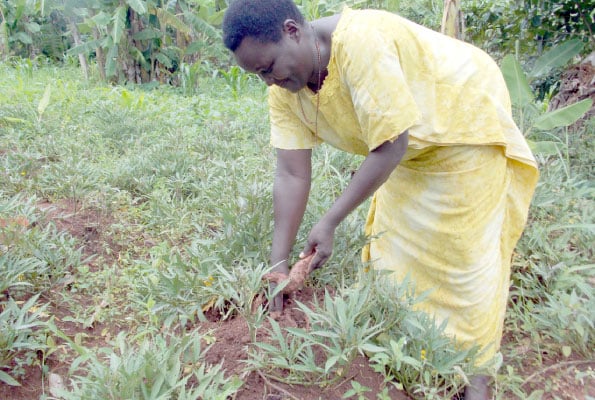Prime
Solving malnutrition through bio fortification

A farmer harvests a bio-fortified sweet potato.PHOTO/MICHAEL J SSALI
What you need to know:
- Recently, scientist at the National Agricultural Research Laboratories (NARL) introduced genetically modified bananas that are rich in vitamin A and iron.
- This groundbreaking modification took the scientists a period of 20 years to create the orange tint in the flesh of the bananas.
Animal-based food though good sources of vitamin A are expensive for poor rural people. This is the reason scientists came up with the idea that common and staple foods be biofortified with provitamin A to offer a convenient and accessible source of the vitamin.
Bio fortification is the process where nutrients are added in a plant when it is growing in order to improve the nutritional quality of food crops. This is done through conventional breeding methods and crops of the same species are used as opposed to genetic modification technology where foreign genes are transferred into the plant.
It is also very different from fortification which happens during the processing of foods industrially. The plant grows and matures but during the industrial milling a particular nutrient that may have been lost during the processing is added back to the flour or any other product formed after the processing.
Any plant can be bio fortified depending on the need according to Dr Gaston A Tumuhimbise a lecturer at the department of food technology and Nutrition at Makerere University. “When choosing a crop to be bio fortified, we look out for plants that will reach and are consumed by many people because there is usually a need to address a general public health concern about a particular nutrient deficiency,” he remarks.
Which plants?
Any plant can be bio fortified but the reason why some plants are a priority is because the crops are consumed by a big population.
So far in Uganda, there are orange fleshed sweet potatoes which are fortified with beta carotene which when digested in converted into Vitamin A. The deficiency of vitamin A in Uganda and many developing countries is very common which leads to a poor and weakened immune system and sight problems. Dr Tumuhimbise says, “Beans are the commonest source of proteins for so many Ugandans. They are served in many schools too.
According to the Ministry of Health, iron deficiency is becoming a public health concern especially among women of childbearing age and children. The beans fortified with iron are very handy in addressing the problem.”
Recently, scientist at the National Agricultural Research Laboratories (NARL) introduced genetically modified bananas that are rich in vitamin A and iron. This groundbreaking modification took the scientists a period of 20 years to create the orange tint in the flesh of the bananas.
Other crops such as maize, cassava and golden rice have been biofortified and accepted in many communities in Uganda with many farmers growing them not only for subsistence but also commercial purposes.
The nutrients chosen
The nutrients chosen for bio fortification are those that are of very serious health concern in Uganda and other developing countries.
Uganda ranks number five out of 123 countries that have the iron deficiency and are suitable for investing in iron beans because they provide up to 50 per cent of daily iron needs according to Sylvia Magezi the country director of HarvestPlus.
About 32 percent of Ugandan children under five years are estimated to be vitamin A deficient according to the Uganda Demographic Health Survey 2016. From the same survey, 49 percent of Ugandan children under five are estimated to be iron deficient.
Iron deficiency impairs mental development and learning capacity, increases weakness and fatigue, and may increase the risk of women dying in childbirth.
The process
Bio fortification is usually done through conventional selective breeding and focuses on making plant foods more nutritious as the plants are growing, rather than having nutrients added to the foods when they are being processed in the industries.
“The process of bio fortification is done through the transfer of pollen grains at the flowering stages of the plant with the variety of the desired nutrient until you get the required amount of the nutrient. The orange fleshed sweet potatoes,” says Dr Tumuhimbise.
Once a farmer has the vines or seeds of these foods, they can grow them the same way they grow the other sweet potato or bean varieties. There is no specialised care needed for the crops.
The varieties
The iron rich bean varieties include Roba 1 (bush); Narobean 1, 2, 3 4C and 5C which mature in 60 to 68 days compared to the normal beans that usually take about 90 days to mature.
The beans grow well in low altitude areas and can stand drought periods. They also yield high with an average yield of 1,700kg per acre.
Magezi says, “Vitamin A Orange Sweet Potato Provides up to 100 per cent of daily vitamin A needs and the varieties include Ejumula, Kakamega, Vita, Kabode, Naspot 12 O and Naspot 13 O. They mature in four months and their resistance to diseases depends on the variety.”
Making the foods available
Harvest Plus supports the National Agricultural Research Organisation (Naro) to breed, test, and release varieties of orange fleshed sweet potatoes and iron beans. Sweet potatoes rank third among the common food staples in Uganda, and are often eaten with beans in many parts of the country.
Magezi says, “We establish and train local multipliers to produce vines and seeds of these particular varieties, and we engage local laboratories to micro-propagate clean vines. Poor farmers receive vines or seeds that they “pay forward” by sharing with other farmers upon harvest.”



